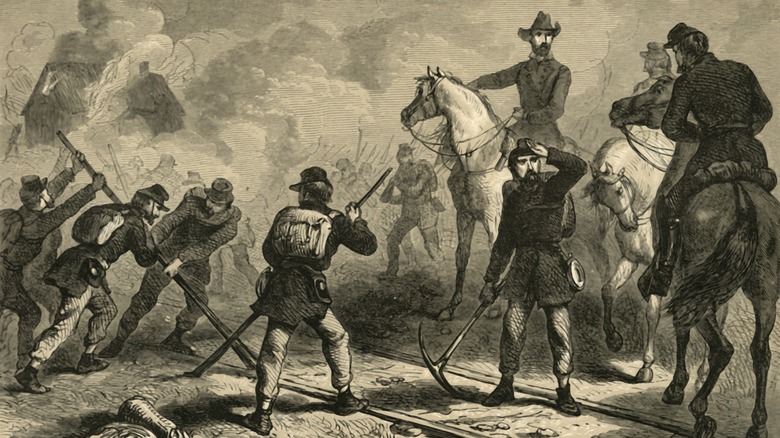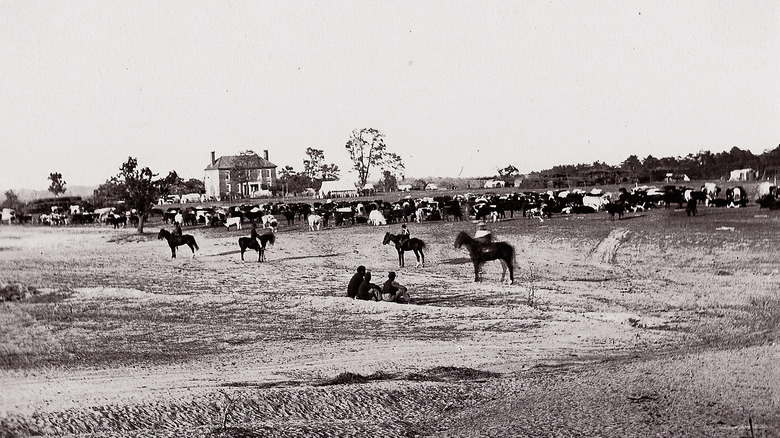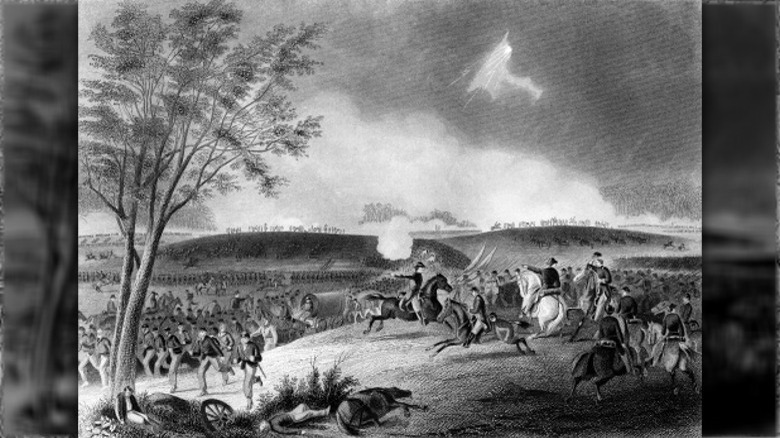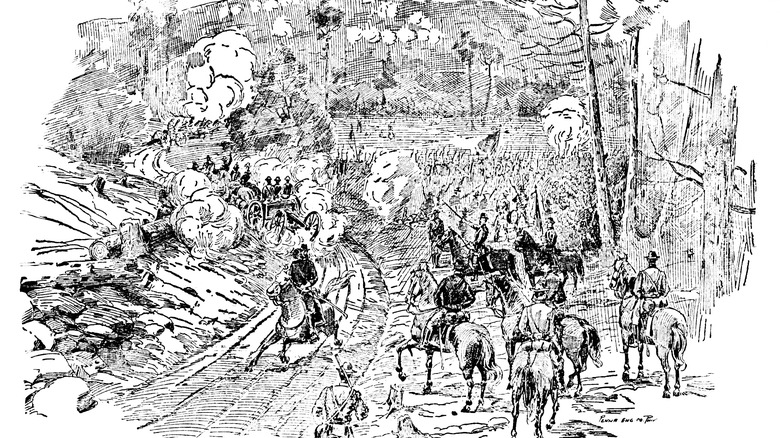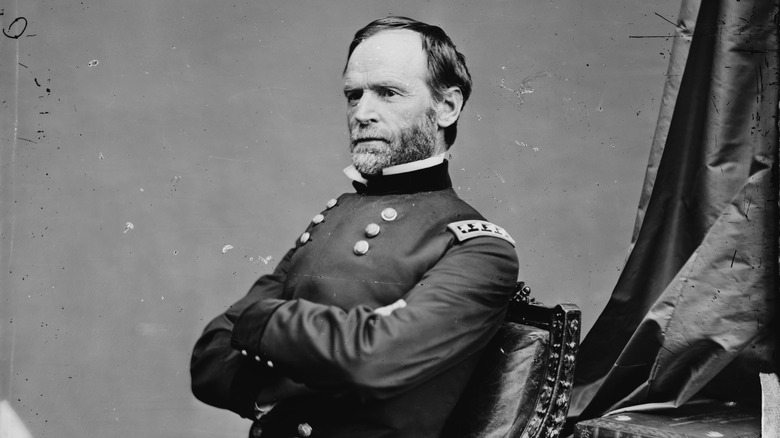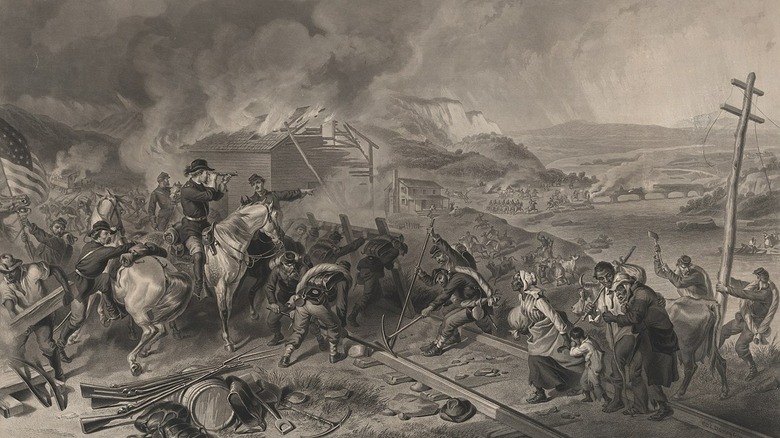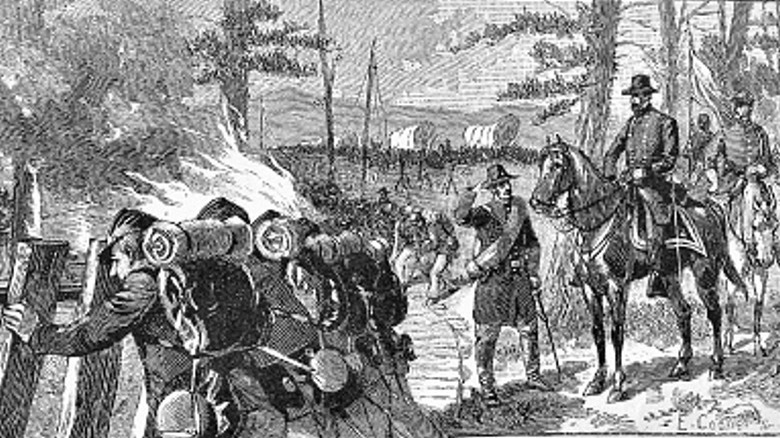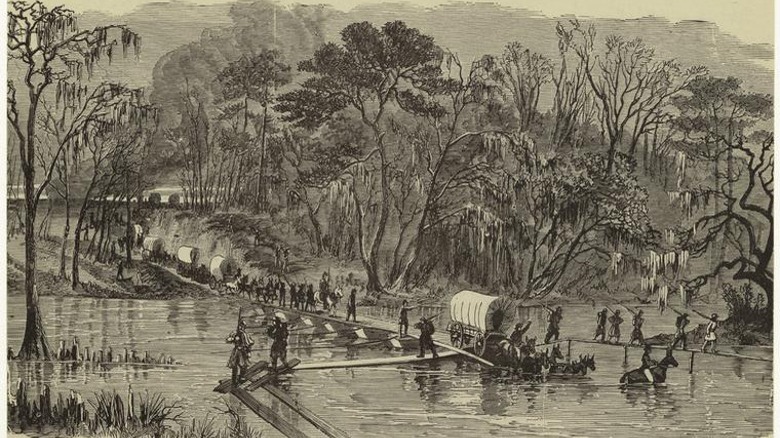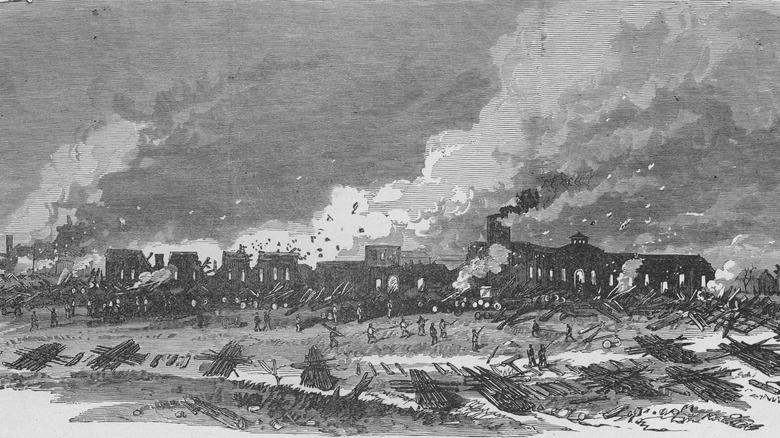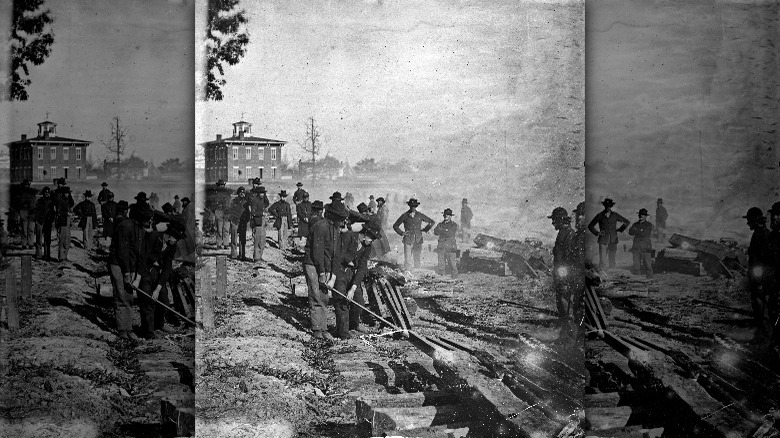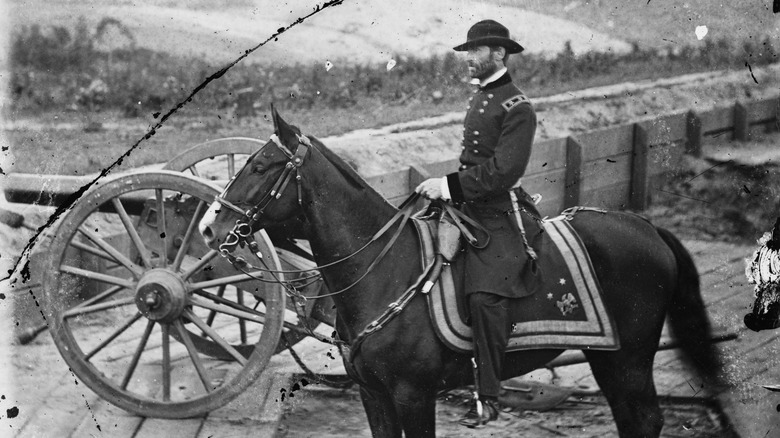Why Sherman's March To The Sea Was So Devastating For The Confederacy
When it comes to the Civil War, there's no shortage of famous battles and moments. After all, the Battle of Gettysburg is widely known by its name alone, or you could look to somewhere like Antietam if you're curious about one of the bloodiest battles of American history. But if you're looking for one of the most controversial events of the war, then you'll probably come across Sherman's March to the Sea.
Generally speaking, this was a military operation that took place near the end of 1864 (specifically from November 15 to December 21) — not too long before the end of the Civil War — led by Union General William Sherman. But this wasn't a typical campaign, where opposing armies were meeting in head-to-head battles (at least, not for the most part). Instead, this was an infamous, nearly 300-mile trek through Georgia (from Atlanta to Savannah) undertaken by Sherman's troops, in which they waged war against Southern infrastructure, as well as the general morale of Southern civilians.
Ultimately, the march was successful, and it earned Sherman quite a reputation, both as the popularly recognized inventor of total war, as well as something of a brute. And each of those viewpoints is applicable to what, exactly, made the March to the Sea as devastating as it was.
The destruction was very targeted
One of the most straightforward and clear reasons why the March to the Sea was so effective in hurting the Confederacy involves logistics. After all, this wasn't some hastily designed plan, with the sole purpose of sowing sow chaos and destruction through parts of the South.
In the grander scheme of things, Georgia was a pretty effective state for William T. Sherman to lay waste to. The state was well-known for being something of an agricultural hub, with especially fertile land more than capable of feeding Confederate troops. Burning through that land would mean that the Confederate army wouldn't have the food they would need to continue the war, and it would give the Union army plenty of chances to fill up their own supplies. And to get even more specific, the specific strip of land that Sherman chose was a tactical one. It started in Atlanta, where a Union victory in a Confederate landmark had already greatly demoralized the people, and continued through the most fertile counties that Georgia had to offer, as reported by the most recent census at the time.
On a smaller scale, individual buildings and businesses were targeted and destroyed because it was largely believed that the Confederate armies were surviving on the charity of those local industries. So, all of those supplies and infrastructure had to go, to ensure that Confederate troops couldn't access them.
Effective psychological warfare
The intentions of the March to the Sea were two-fold. There was the tactical aspect, involving the destruction of supplies and infrastructure. But it also had a less quantifiable goal: destroying the morale of those who supported the Confederacy.
William T. Sherman saw the Civil War as less of a conflict against the Confederate army, and more of a conflict against the Confederate people; in his own words, "[We are] not only fighting hostile armies, but a hostile people" (via History). And that wasn't a line he composed without any kind of reason, as there had actually been prior instances in which Union governments had actually been forcibly reinstalled into Confederate states. In short, the results were underwhelming, to say the least, because the people never supported those new governments, always hoping the Confederacy would retake power.
So, that was the mindset he was planning to change. The point of the march was to sap the spirit of those who longed for the Confederacy, to make them see just what kind of price would be paid for fighting, to lead them to a point where they would just wish it was all done. As one soldier wrote, "It isn't so sweet to secede ... as [they] thought it would be," and that sums it all up fairly cleanly. If the people no longer believed in their cause, it would just be a matter of time before the armies followed suit.
Rampant looting
If there's anything that you already knew about the March to the Sea, then there's probably a decent chance that the looting is the thing you're already familiar with. And that wouldn't be without good reason.
See, part of the logistics that William T. Sherman designed his march around was the fact that his army wouldn't have any sort of supply lines attached to them. They would be traveling with relatively little when it came to rations, and no traditional means of refilling those rations. This wasn't an accident, of course; traveling like this meant that the army could be much faster and more mobile. But that meant supplies would be a natural problem, and so the solution? Foraging. Each regiment would have people specifically assigned to keeping a regular stock of food and supplies, gathered from the (notably fertile) land that they were passing through.
But this became far from a peaceful endeavor. Union soldiers got pretty excited by the idea of foraging, and eventually, "foraging" became something closer to "looting and rampaging." These soldiers actually earned a nickname for themselves — "bummers" — and their reputation wasn't exactly positive. They became known for their brutality and for the terror that they would spread, burning private property, killing livestock, and stealing whatever they could get their hands on.
Officers (and Sherman himself) looked the other way
If you wanted to get into some of the really technical aspects regarding the looting during the March to the Sea, then the place to look might be William T. Sherman's actual words on the topic. And those just happen to be nicely compiled in a set of documents called Special Field Orders No. 120.
What's potentially surprising, though, is the fact that the literal orders don't seem quite as brutal as the events that occurred. Verbatim, Sherman's orders say this: "Soldiers must not enter the dwellings of the inhabitants, or commit any trespass ... [and] this general principle is laid down: In districts and neighborhoods where the army is unmolested no destruction of property should be permitted." Of course, in cases where the army was being antagonized, then those rules got far less accommodating, explicitly allowing destruction, but, as written, private citizens who weren't causing problems weren't to be bothered. Which sounds a lot different from the devastating rampage told about.
But that doesn't mean the rampages were necessarily exaggerated; the "bummers" did wreak havoc. So this apparent dichotomy actually points to a very different factor at play: Sherman was rather willing to ignore the destruction being wrought. He directly saw the looting that was going on, acknowledged that it was too brutal and literal a take on his words, but actively looked the other way. After all, it still accomplished his main goal of weakening Confederate morale.
Southern civilians were genuinely terrified
In the case of any major military operation — Sherman's March to the Sea, included — there's the intention to consider, but there's also the actual execution, as well. So while everything that William T. Sherman laid out pointed to these large-scale mind games on the larger Southern population, there's the question: Did it work?
In short, it did. One Georgian woman actually recounted the experience, explicitly likening the looting "bummers" to demons descending upon all parts of her home and stealing whatever they saw fit. Word was clearly getting around, and it seems that as the stories spread, they also were exaggerated, turned into terrifying legends in their own right. The simple threat of Union looters was enough to cause fear — something that was even further amplified by the inconsistency of the destruction; intentionally, there wasn't a pattern in what sorts of residences the looters would target, or the amount of damage they would do. Both humble homes and huge estates could be burned, or just as easily, they might be entirely spared. No one knew exactly what might happen or who would be hurt, and uncertainty spawned further fear. Then, there's Sherman himself to consider, as those same stories started to portray him as some terrible monster better fit to myth than reality. The fear was palpable enough that Sherman has even maintained the image of a brute into the modern day, gaining infamy that's fairly telling of just how scared people were back in 1864.
The destruction of railroads
Given that this was all going on in the mid-19th century, railroads were a pretty big thing, and for fairly good reason, providing easy delivery of supplies for both the Union and Confederate armies. And so, naturally, they ended up becoming quite the target during the March to the Sea.
Union armies set to work on that, but the funny thing is that, at least initially, they weren't that successful. Sure, the physical rails could just be disassembled, but that far from meant that they were beyond repair. On the contrary, there were a number of occasions where Confederate armies actually did find the destruction and repair it in just the course of a few days. Even bent rails could be straightened out.
So Union soldiers took things further, ensuring that the rails were damaged beyond repair (or, at least, they couldn't be repaired with any kind of speed), and William T. Sherman came up with a new way to do just that: the "Sherman necktie." Essentially, the idea was that the rails would be stacked over a fire and heated; the heat would cause the metal to soften, and that was when soldiers could do real damage, twisting them badly enough that they couldn't be reused without being completely melted down. Soldiers would also wrap the softened rails around trees before twisting — hard to find a use for a rail with a tree in the middle of it. Ultimately, the tactic worked wonders, with even the fastest repairs still taking about a month's time.
Sherman was largely uncontested
If you think about the scope and effect of Sherman's March to the Sea, you'd imagine that the Confederate army would've tried to stop it in its tracks, right? Now, to be entirely fair, they did make an attempt, but the truth still stands that the Union army was, to a large degree, basically unopposed for much of the operation.
On one hand, that had to do with some pretty smart planning on William T. Sherman's part. He kept his cards close to his chest, even going so far as to sever telegraph lines just to make sure it was impossible for information to get out, and keeping many of the details of his plans private, even from his superior officers and the men under his control. Then, when he did let some information loose, it was actually misinformation. Confederate generals thought they had his plan figured out, only to dispatch forces toward cities that Sherman actually had to interest in. That actually left very few forces available to even attempt to stop him — a small cavalry force caused some headaches, and a handful of battles erupted during the March, but they were generally all relatively small skirmishes. Not nearly enough to actually stop the March.
Really, that all sort of culminated in Sherman's arrival in Savannah. The Confederate army was quick to flee at Sherman's presence (or had already abandoned the city, depending on whose account you're reading).
Union soldiers weren't the only ones causing chaos
If you just take a surface level look at everything, then, well, this is Sherman's March to the Sea — literally just by the name alone, this is really clearly an operation headed by the Union. And so, in keeping with that, the general view is that it was mostly Union soldiers under the command of William T. Sherman who were terrorizing the Georgian countryside. But, interestingly enough, that wasn't entirely true.
In actuality, Confederate troops also sowed their own fair share of destruction over the course of the March to the Seat. See, Sherman earned some level of notoriety for the burning of Atlanta, which took place on the first day of the march. The overall picture painted of the event is pretty brutal, but it's not exactly that simple, either. Though buildings were burned, this wasn't a pristine city that was engulfed by flames; on the contrary, the city had already been torn apart by Confederate soldiers before they fled. Trenches dug into the ground, and supplies that were destroyed at the orders of Confederate officers, who wanted to make sure that there wasn't anything left for the Union army.
And that logic carried over to the rest of the March, as well. While Sherman's army was on the move, Confederate soldiers actually rushed ahead of them, desperate to handicap them as much as they could. Burning bridges, burning stores of supplies, and the like — anything to make it such that Union troops couldn't use those provisions for themselves.
Long-term effects on the economy
Certain aspects of Sherman's March to the Sea — as well as aspects of William T. Sherman, himself — have grown in their infamy, They're both remembered through a brutal and bloody lens, and while you can't really argue that a description like that isn't untrue, it's also worth noting that stories can be (and often were) exaggerated. But something that doesn't lie quite so easily? The statistics.
Speaking to the immediate effects, enough of the countryside and local industry was destroyed that the losses totaled to about $100 million — or, if you want that number when accounting for inflation, you're looking at losses coming out to $1.5 billion. And given that the short-term effects were so devastating, it only follows that there would be some pretty massive long-term effects, as well. Agriculture in general took a huge hit, with land values dropping in the years immediately following the end of the Civil War. What's more, those markets just had a really rough time recovering, owing, most likely, to a lack of robust financial and economic infrastructure to lean on. And that rough time lasted more than just a few years. On the contrary, it lasted a number of decades, with some studies indicating that the ripples of Sherman's March to the Sea could be felt as late as 1920 — over 50 years after all of this took place.
Sherman's view was actually pretty complex
In general, William T. Sherman has been remembered by history as something of a brute — the person who spearheaded a destructive rampage through the state of Georgia. And it's not like that's an entirely inaccurate picture, but it's not a fully accurate one, either. Sherman actually had a lot more in mind than mindless violence.
In actuality, Sherman admitted to having no real love for that violence, and his intention behind the March was to end the War earlier, thereby saving more lives in the process. What's more, he explicitly said that destruction would only be saved for those who were still rebelling. But people who decided to surrender? Then they wouldn't see any of that destruction turned against them
And that wasn't just a bunch of meaningless, empty promises; Sherman actually did follow through. When his army arrived in Savannah and took the city, he also found that some Confederate leaders had left their families behind while they fled, actually trusting Sherman enough to keep them safe, despite the circumstances. Not exactly what you'd expect from a man who's been made to look like a beast. And beyond that, his peace terms were almost notoriously generous, with one such occasion actually being enough that it turned the heads of some Union generals, who even began to wonder where Sherman's true loyalties lay. (To be clear, he did fully support the Union, but it just went to show how much he practiced what he preached.)
